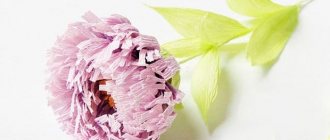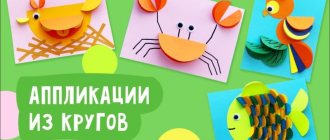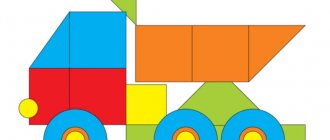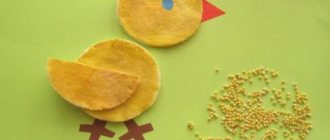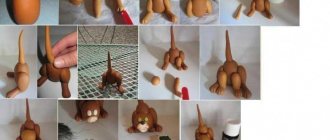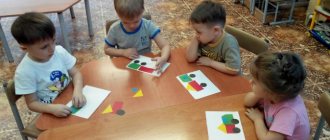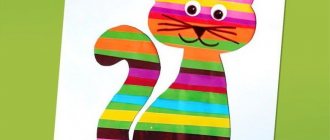How to make appliques from paper Wild animals. Print our free templates, color them however you like, cut them out and glue them together!
The proposed applications - a symbiosis of coloring books and cut-outs - will be useful for the development of the child. They will help improve coloring, cutting, designing , develop fine motor skills, precision of movements, spatial thinking, attentiveness, and perseverance.
See also:
- colored paper applications,
- learning to cut with scissors - the simplest templates.
Print applique templates Animals
Applique Grizzly Bear
Grizzly Bear Facts
- Although grizzly bears are not endangered, an existential threat exists. 1,000 grizzly bears left in the wild .
- Grizzly bears are a North American subspecies of brown bear.
- Grizzly bears are often seen at some of Alaska's best fishing spots, where they feast to accumulate enough body fat to survive the winter.
- During the winter, grizzly bears hibernate. They dig holes on the hillside. Females give birth at this time.
- Grizzly bears are powerful predators, although they eat a wide variety of foods. Nuts, seeds, berries, fish, rodents and moose!
Explanation of the application execution procedure
In order for children to complete their work successfully and enjoy the activity, the teacher needs to clearly and clearly explain the procedure. It will depend on the choice of techniques, materials, and whether preschoolers work together or individually.
Almost all instructions are accompanied by a demonstration of intermediate stages of work, but for some types of application this is not possible, for example, recently glued cereal will fall off the sheet if it is placed in a vertical position. Children need to be introduced to such techniques in advance, in their free time, and then verbal instructions will be sufficient during the lesson.
Item trim applique
The most common method is subject application. It helps to develop skills in using scissors and paper, and gives the teacher the opportunity to see which of the children successfully cope with program tasks and which need individual help. Algorithm for making paper trim applique:
- Each child completes the applique on a separate sheet.
- We prepare parts depending on the selected animal.
- We lay out the details on the background so that the image is in the center; you can use the sample.
- We glue it in this order: body, head, paws, tail, small details (ears, eyes, mouth). You can draw faces with felt-tip pens or pencils. Smooth it out with a napkin.
- If desired, decorate the background with snow, grass, flowers, etc.
Photo gallery: finished works using the cut applique technique
The children complemented the squirrel figurine with a design of a pine branch and a foil nut.
The image of a cat consists of ovals and circles that the preschooler needs to cut out from squares. The “Elephant” applique uses many additional decorative details, so it is better to divide it into two classes or between two children
A child of the sixth year of life can make this figurine of a fox independently.
Making a collective silhouette applique
All children in the group participate in the collective application. If the group is large, it is divided into two subgroups. The work is performed in the following order:
- We attach the stencil or template to a sheet of paper. If the paper is not double-sided colored, choose the white side.
- We outline the image of the animal.
- Cut along the contour.
- We turn it over, glue it or add details.
- Turn it over again and apply glue along the edge of the silhouette.
- We choose a place for the figure on a common sheet, glue it, smooth it with a napkin.
Usually, in group work, children in the older group already agree themselves who will place their parts of the image and where. For those who can do it faster, the teacher offers to decorate the background by gluing small decorative elements (large ones are glued in advance, before class).
Photo gallery: examples of collective works using the silhouette appliqué technique
An applique on the theme “Farm” can also be made using the collage technique, using clippings from magazines or printed images of characters
The panel “Sheep in the Meadow” combines silhouette and mosaic appliqué techniques
The funny penguins on this applique are made according to a template and complemented with trimmed details
Collective works depicting animals from hot countries also look great, because their silhouettes are easily recognizable and varied.
Performing mosaic applications in pairs or subgroups
Children receive sheets with ready-made animal outlines. The materials for the mosaic are scraps of paper, balls from napkins (pupils roll them up in advance in their free time), cereals, padding polyester or cotton wool, poplar fluff, and plant seeds. The work flow is as follows:
- The image is coated with glue in small areas, starting from the top.
- They glue the materials, guided by the ready-made sample and the teacher’s advice.
- Allow the appliqué to dry and then remove excess materials, carefully shaking them onto a scrap plate.
- Finish drawing or gluing on details.
Mosaic application is the most labor-intensive, requiring perseverance, painstakingness and patience, so for it you need to choose the simplest images with large parts.
Photo gallery: finished works and templates for mosaic application
This bunny made of cotton wool and cotton balls was made collectively
Mosaic applique “Fox” can be done by one or two older children
The giraffe from the cereal will be erased very positively and colorfully
When looking for templates for applique on the Internet, you should pay attention to the numerous coloring books for kids. With such positive animal templates, the applique will turn into a fun game. When making applique from cereals using this template, it is better to finish the tail and horns or use threads or ribbon
Application from ready-made elements
This type of application is the simplest; image preparation is minimal. It requires cotton pads, leaves, geometric shapes. Children may only need to cut and bend the finished pieces in half. The main thing that is needed is the ability to compose and design a beautiful composition. Planar design skills are already required here. Students love this technique because almost everyone can do it, and the finished work has a very attractive, impressive appearance.
An application made from ready-made forms can become an illustration for your favorite fairy tale or cartoon
In an appliqué made from ready-made parts, even one child can depict several figures, part of a landscape, an animal’s home, or illustrate an episode of a favorite fairy tale. This type of application is also suitable for working together. How to perform this application:
- We think about what we will place and where, which parts will be useful intact, and which need to be cut and bent.
- We bend and cut, if necessary, some elements.
- We lay out the parts of the application on the background, forming a completely finished composition.
- We take each part in turn, spread glue along the edge and put it in the same place where it was. Gently smooth it through a napkin (dry leaves and twigs do not need to be smoothed, children pay attention to this).
- We decorate with small elements.
Photo gallery: samples of applications from ready-made forms
An application can consist of only circles, but at the same time it can be difficult to complete, requiring attention and the ability to select colors
To convey the image of a puppy, children need to think about how to position the tail and ears, because the hero’s emotions depend on this
The lamb in the meadow was made from cotton pads and cotton swabs, complementing the composition with ready-made flowers on an adhesive base. An original cat made from cotton pads will decorate a corner of nature
Children can make these hares in pairs
The elephant figurine will require preschoolers to diligently convey the shape of the legs and trunk
Ready-made shapes combined with silhouette cutting created a wonderful picture of a summer farm
By gluing the “needles” of this hedgehog, children coordinate their actions so that the animal looks smart and neat
Paper applique Raccoon
Raccoon Facts:
- Raccoons will eat anything. Insects, mice, fish, eggs and even garbage!
- Because they eat almost anything, you can find raccoons in any environment - from the farm to the city!
- Raccoons love to live in hollows, logs, and even attics! Young raccoons often spend the first two months of their lives high in tree holes until their mother drops them to the ground.
- Raccoons typically live 2-3 years in the wild.
- Northern raccoons hibernate - they binge on food to store fat and then sleep in their den all winter.
Structure and duration of application lessons
Most often, an application on the topic “Wild and Domestic Animals” is carried out as an independent lesson. However, it is also possible to organize a complex lesson, during which cognitive activities alternate (children learn interesting facts about animals, make an imaginary journey to distant countries, get acquainted with their inhabitants), gaming, that is, didactic games about animals and visual - direct making of an application.
Table: structure and duration of application lessons in the senior group
| Lesson stages | Subject lesson | Complex lesson |
| Introductory part | Organizing children, creating a positive mood, communicating the topic of the lesson. 3–4 min. | |
| Main part | Motivational stage, surprise or game moment. Introductory conversation. The teacher shows how to do the work. Visual activities of children. 15–17 min. | Alternation of various types of activities (cognitive, search and research, gaming, visual) in accordance with program tasks. 20–22 min. |
| Final part | Summing up the lesson, reflection, teacher assessment and children’s self-esteem. Up to 3 min. | |
Thus, in general, a subject (unidirectional) lesson lasts no more than 25 minutes, and a comprehensive lesson, due to the expansion of the main part, can be longer by 5–7 minutes. In the middle of the lesson, finger exercises or physical education are performed.
Table: lesson notes on applications in the middle group on the topic “Red Squirrel”, prepared by O. V. Molchanova
| Program tasks |
|
| Materials and equipment | Scene pictures with the image of a squirrel, squirrel templates for each child, cotton wool, glue, colored paper, napkins. |
| Lesson stage | Contents of the stage |
| Educator: - A red-haired little animal jumps and gallops through the trees. He lives not on the ground, but on a tree in a hollow. A red tail here and there suddenly flashed through the bushes, a girl looked after her, she knew it was... (Squirrel). | |
The teacher shows the children a toy squirrel. - Guys, the squirrel is bored alone, she needs friends. Let’s look at the image of a squirrel with the children:
Physical education minute
Educator: - You have squirrels on the tables, only they are all white. Look, guys, my squirrel is red and has a fluffy tail. (Shows a sample). Explains the technique of doing the work: first, carefully lubricate the area on the sheet with glue and tear off small pieces of colored paper and glue them onto the sheet. Apply cotton wool to the tip of the tail and ears. (Includes music for a creative atmosphere). | |
| At the end of the lesson, the teacher organizes an exhibition of works. He thanks the children for making many friends for the squirrel, offers to look at all the works, choose the most interesting ones, explain their choice, and encourage the children to clean their workspaces. | |
| Quoted from: | https://ped-kopilka.ru/blogs/blog63705/konspekt-nod-v-starshei-grupe-aplikacija-na-temu-ryzhaja-belochka.html |
Lion clipping
Facts about lions:
- Lions live in groups called "prides".
- Male lions boast a mane, a large fringe that encircles their heads.
- Males defend the pride territory, which they clearly mark with the smell of their urine.
- Lionesses are hunters in a pride. They often work together to hunt antelope, zebra, wildebeest, zebra, etc.
- Most lions on earth live in Africa, although a very small population can be found in India's Gir Forest.
Organization of an application on the theme “Animals” in the senior group
An application on the topic “Wild and Domestic Animals” in the senior group is a great way not only to consolidate the knowledge, skills and abilities of children, but also to help foster love for our smaller brothers, kindness and humanity. By developing these qualities in students, teachers help children socialize and establish relationships with others, which is especially important for future schoolchildren.
Having chosen which animal the children will portray, the teacher must first think through the following questions:
- Will it be a subject (one animal) or a plot application. In the second case, several characters and additional details are required (shed, kennel, image of a forest clearing, etc.), which also need to be prepared. It is very difficult for one child to make a trimmed or mosaic plot applique, but if it is an applique from ready-made forms, it is quite possible.
- How many children will work on the work. It is possible to make an application by one child, in a pair, in a small subgroup (3–6 people), or by the whole team. Collective work is appropriate if the work is voluminous or complex (collage, mosaic, combination of various techniques).
- Application size. It can be done on standard A4 sheets if 1-2 children are working, but for collective and subgroup applications it is better to take A3 sheets, the kids will be able to sit comfortably around them and create a composition without interfering with each other. The details should be of such a size that the entire image looks harmonious.
There should be enough space on the sheet not only for the animal itself, but also for the accompanying parts
The application must be made accessible to every child, that is, tasks must be individualized depending on the level of preparation and abilities of the children. After all, children have different skills and pace of activity. Some cope faster and may get bored, others have difficulty using scissors and cutting techniques. This is especially true for newcomers who came to the senior group from home. Such children can be offered ready-made parts, templates or stencils, while their more prepared peers make appliqué parts on their own, using previously acquired skills. For those who can do it faster, you can offer an additional amount of work: decorate the background with details, draw or stick on food for the animal, and other small elements.
Wombat paper applique
Wombat Facts:
- Wombats are marsupials, meaning they have pouches on their bellies in which they raise their babies.
- A baby wombat lives in its mother's pouch for about five months before it emerges.
- Wombats use their claws to dig burrows in eucalyptus forests and grasslands.
- Wombats are nocturnal and they are vegetarians (herbivores). They come out at night to eat grass, bark and roots.
- A wombat that burrows in fields can be a destroyer of ranches and crop-dependent farms.
Craft Panda
Panda facts:
- Pandas are an endangered species.
- They eat about 28 pounds of bamboo a day!
- Adult pandas weigh about 300 pounds (136 kg).
- Wild pandas live only in remote mountainous areas of China.
- Pandas are solitary animals.
Anteater applique
Anteater Facts:
- They are edentulous animals, meaning they have no teeth at all.
- Anteaters use their long tongues to swallow 35,000 ants and termites every day!
- They find food by smell.
- Anteaters live in tropical forests and grasslands of Central and South America.
- They live for about 14 years and are classified as endangered.
Motivation for visual activities
Children in the older group perceive the teacher not only as a source of information, but also as a friend and interlocutor. The best motivation for depicting animals will be to appeal to the experience of the students, their feelings and emotions. Surely the children have experience communicating with animals; many have pets at home, they have seen cattle in the village, and wild animals in the zoo, on TV. A conversation about these impressions will help the teacher direct activities in the right direction and create a trusting atmosphere in the lesson.
In addition, they use visualization (object and plot pictures, excerpts from cartoons, videos with animals), artistic expression (riddles, poems, fragments of stories and fairy tales about animals), playful and surprise moments, problematic situations, for example:
- Lesovichok comes to the children. He is very upset, because winter has come (the class is held in winter), and many of the inhabitants of the forest have fallen into hibernation. And Lesovichok misses his friends so much! He doesn't even have their portraits. The teacher invites the children to cheer up Lesovich by making portraits of forest animals that hibernate as souvenirs.
- A learned gnome sends a letter to the group. His little grandson cannot remember the names and types of animals in hot countries. The learned gnome asks the children to make a large, interesting picture with several animals from the tropics. Children discuss the problem and decide to make a collective applique with the image of a giraffe, zebra, elephant, rhinoceros, etc.
- Their favorite fairy-tale character (Dunno, Carlson, etc.) comes to the children. He reports that he has a pet, describes it, asks the children if they have pets, who they would like to have, what funny habits the animals have, and then invites the children to portray their favorite animal. This theme helps to unleash the imagination and creativity of children, and there is nothing wrong with little ones portraying puppies with wings or lilac and pink kittens, because they are not just conveying images of existing animals, but their dreams. In such work, it is good to combine appliqué and drawing, that is, the children paste the silhouette of the animal and draw the details.
Educators should remember that fish, birds, insects, and reptiles are also animals and their depiction will not be a mistake.
In any case, it is worth considering that children in the older group are looking for a partner, a friend in a teacher, so it is necessary to treat their ideas and proposals with understanding and interest, to support and develop manifestations of initiative, original thinking, and self-expression.
What is most important in visual arts is the joy of free creativity.
Craft Warthog
Facts about warthogs:
- The "spikes" and bumps on a warthog's face... those are warts!
- They are from the same family as the cute domestic pigs, although they look different.
- They have 4 tusks (although our template only shows two).
- They eat grass and plants and dig up roots and bulbs.
- They live for about 15 years.
- Warthogs can go for long periods without drinking water.
Baboon cutout
Facts about baboons:
- There are 5 different species of baboons and they all live in Africa or Arabia.
- Baboons are one of the largest monkeys in the world. Males weigh on average from 15-37 kg.
- Baboons prefer savanna and other semi-arid habitats.
- They don't have prehensile tails like other monkeys, but they can climb trees to sleep, eat, or wait out trouble.
- Baboons eat fruits, herbs, seeds, bark, roots, meat and love to eat farm crops.
- They are known to form large orders of baboons, ranging from tens to hundreds with a complex hierarchical system.
- They can live about 30 years.
Lesson notes on the application “Zoo”
In the notes it is always d.b. etc. sod., not the goal. The words Educator are usually not written. And immediately there is direct speech - an address to the children, and in parentheses - the expected answers of the children.
Lesson notes on the application “Zoo”.
Purpose: Program content
— 1. Learn to display the characteristic features of animal images in an application. 2.Develop constructive abilities in drawing up a portrait (silhouette) of an animal from its parts. Strengthen the ability to cut out shapes from paper. Continue learning to cut out shapes along the contour. 3. Strengthen skills in working with scissors, glue, and a brush. 4. Develop accuracy, perseverance, and patience in children. To form an aesthetic attitude towards the work performed.
Material and equipment
Progress of the lesson.
Part 1 – introductory.
Educator: - Guys, Alf took a book from the book corner, and in it were riddles about animals. Alf can't solve a single riddle. Let's help Alpha? The children agree to help Alf.
Educator: -Alf, what riddles did you like, read them, and the guys will help you solve them.
Alf asks the children riddles:
It’s easy for us to recognize him, It’s easy to recognize him: He’s tall and sees far. (Giraffe)
In the zoo, Believe it or not, Lives a Wonder Beast. His hand is in his forehead. It looks so much like a pipe! (Elephant)
Children solve riddles.
Educator: - Alf, you see how easily and simply the guys can solve riddles.
Alf: Guys, where do elephants and giraffes live? Children's answers.
Alf: And on my planet, where I came from to visit you, there are no elephants or giraffes.
Educator: Guys, let's give Alpha a gift. We will make appliques of an elephant and a giraffe and give them to Alpha. The children agree.
Alf: I'm so glad, thank you guys.
Part 2 – the main one.
Educator: - Guys, what are we planning to do? Answer - (application of an elephant and a giraffe0. - What materials do we need for this? Answer - (colored paper). - What tools do we need? Answer - (glue, brush, scissors). - And how will we make an elephant, the sequence of actions I I’ll show you now (technical demonstration by the teacher).
Educator: -Guys, prepare your workplace. For those children who want to make an elephant for Alpha, take strips of gray paper, and for those children who want to make a giraffe, take strips of orange paper. (you can ask the children themselves about this)
Children independently cut out parts from strips of paper to applique the selected animal. Place the silhouette of an animal from the parts on the backing, spread and glue the parts. The teacher helps children only if the children have difficulties.
Part 3 is the final one.
Alf examines the children's work and thanks the children.
Alf: Guys, where can you see a giraffe and an elephant? Children's answers.
Alf: It’s good that I now know that you can go to the zoo and see animals that live not only in Russia, but also in other countries.
Educator: -Alf, sit on the chair, and I will read you a poem about the zoo, and the guys will show you a finger game.
Finger game "Zoo".
We are going to the zoo Material from the site www.logoped.ru
(index and middle fingers walk on the table)
,
Everyone is happy to be there (claps hands and knocks fists)
There are ponies, zebras, crocodiles, parrots and gorillas, there are giraffes and elephants, monkeys, tigers, lions. (bend fingers)
And in our hands we have a gun (show the gun with your hands),
It takes photographs
(pretend to be a camera),
Let’s take a photo for everyone (show with hands),
This is how you want to hunt
(clench and unclench your fingers).
game "Zoo". Educator: Guys, now try to portray the animals that live in the zoo.
Coordination of speech with movement: “Animals”
This is a lion. He is the king of beasts, there is no one stronger in the world. (we walk in a circle leisurely, raising our heads)
And funny monkeys shook all the vines. (spring, standing in a circle, feet shoulder-width apart)
But the smart, kind elephant sends his bow to everyone. (palms pressed to the head, body tilted forward - to the right, forward - to the left)
The leopard jumps so deftly, like our favorite ball. (jumping in place)
The pony runs, frolics, wants to make friends with us. (running in a circle with jumps)
The zebra shakes his head and invites him to visit. (hands on the belt, head tilted left and right)
Craft Leopard
Leopard Facts:
- Leopards are an endangered species.
- They are strong hunters and love to be in trees. In fact, they often drag their prey up trees to eat it!
- They are nocturnal.
- Leopards are very secretive and hunt antelope and deer under the cover of tall grass.
- They are also good swimmers and love to be in the water.
- Leopards are light colored with black spots called rosettes. There are also black leopards, commonly known as black panthers .
Fennec cutout
Fennec Fox Facts:
- The fennec fox is the smallest fox species in the world.
- They have huge bat-like ears that help radiate body heat and keep them cool in the desert.
- They mainly live in North Africa and the Sahara Desert.
- They have long hair, which keeps them warm on cold nights and protects them from the hot sun.
- They live in underground dens in small communities of about ten foxes.
- Fennec foxes are omnivores and eat both plants and small rodents, eggs, reptiles and insects.
- They can go without water for a long time.
Howler monkey paper applique
Howler Monkey Facts:
- Howler monkeys live in tropical areas of Central and South America.
- They howl so loudly that they can be heard up to 5 km away.
- They have what is called a "prehensile" tail, which means they can use it as an extra hand to grasp branches.
- Howler monkeys can live 15-20 years in the wild.
Crafts – applications from autumn leaves. The best photo ideas on the topic “Animal World”
0
Crafts with children. Beautiful autumn applications from dry leaves
The time has come for a bright and colorful autumn. Now yellowed, fallen leaves rustle underfoot. In the park where we walk with the children, the leaves are simply incredibly beautiful - crimson, orange and yellow. So, while walking, we always collect a bouquet of these colorful foliage. It’s not for nothing that golden autumn pleases us with its colors! Autumn leaves seem to be specially created for creativity: red, brown and yellow, of the most incredible shapes and sizes.
So now we have a collection of autumn leaves. We will use them to make crafts with the children. Maybe you too, having looked through our photo gallery “Crafts - applications from autumn leaves. The best photo ideas for preschool children” suddenly you want to make a wonderful applique of dry leaves with your own hands together with your child. Such creative work can be done for an autumn holiday or exhibition, or just for the mood. Preschool children will be happy to take part in creating such crafts, and schoolchildren can easily make them on their own.
It is a very exciting activity to watch how ordinary leaves that lay under our feet turn into funny little animals, people, landscapes or abstract patterns. Applique classes with children contribute to the development of fine motor skills, imagination, accuracy, and develop perseverance. After all, creativity is an important component of the harmonious development of your child!
And a little advice: before you start working, you can iron the collected leaves by placing them between two sheets of paper. When making autumn applications from leaves, the missing details of your fairy-tale scenes can be completed with pencils, felt-tip pens or paints.
Happy creativity! Share your works, send their photos to us by email and we will be happy to post them in our section!
Autumn applique “Hedgehog”
Applique of autumn leaves
Ideas for autumn crafts from dry leaves
Leaf craft “Butterfly”
Craft from autumn leaves “Mouse”
Application of dry leaves “Toad”
Crafts with children on the theme of autumn. “Chicks and Birds”
Autumn application from leaves. “Rooster” Photo of ideas for crafts made from autumn leaves. "Turkey"
Craft – applique “Dinosaur” Beautiful applique from leaves “Wolf and Wolf Cub”
Idea for a craft made from dry leaves “Bunny”
Applications for children. “Fish”
Crafts with children. “Water World”
Autumn collage of dry leaves. “Cow” Photo of ideas for crafts from leaves “Elephant”
Collage of their autumn leaves. "A lion"
We will continue to cover this topic on other pages of our educational children's website Go Funny Kids, where you can see other photo ideas for crafts from autumn leaves, applications and collages. We offer for your viewing the section “Collage of dry leaves. Photo ideas for creative activities with children”
Facebook Comments
Gorilla cutout
Gorilla Facts:
- Gorillas are classified as endangered.
- There are only 700 mountain gorillas left on Earth.
- Although their numbers are slowly increasing due to conservation efforts, habitat loss and poaching still pose a major threat to these animals.
- Baby gorillas love to ride on their mother's back.
- Gorillas are herbivores and primarily eat bamboo and other leafy plants.
- Gorillas can live 40-50 years.
- They are very smart!
Schemes and descriptions of work on the application of domestic and wild animals
Photo gallery: finished works of children
To complete this craft, children will have to work hard, rolling up cotton balls. In this application, children glue the parts onto the base, and the teacher “attaches” the figure with a stapler to create stripes on the skin.
The original use of the outlined arms and legs can be found in the applique
From the leaves of different tree species you can create whole pictures
Such an applique can be glued to the base and exist in the form of a three-dimensional picture.
Photo gallery: animal templates
This dog is quite easy to cut, since it does not have too small elements
This template is convenient for mosaic application
Children enjoy repeating geometric shapes, working with them as part of the appliqué
Such a turtle needs to be printed out in color, and children can draw spots on the shell themselves and fill them, for example, with buckwheat
To make an elephant you will need to cut out quite small parts. The spots on the cow can be made from velvet paper
Pets
Let's look at examples of the application of the most “popular” pets.
"Dog"
In the older group, kids can work with 2-3 types of materials for mosaic application
This is an example of a mosaic application in which children cover the outline of the picture with cereals: millet, buckwheat, rice, and also use peas.
Instructions:
- Children receive a template with a picture of a dog, PVA glue and separate bowls of cereal and peas.
- Kids first apply glue to small areas to fill.
- Start by placing peas on the back paw.
- After this, they start with rice, which fills the eye and the spot on the chest.
- We fill the nose, ear and spot on the side with buckwheat.
- Finally, fill the remaining space with millet.
"Cat"
The cotton wool applique looks very unusual and voluminous.
The figure of a pet is made using mixed media: we add voluminous details made of cotton wool to elements made of colored paper.
Instructions:
- The guys receive templates (a figurine of a cat and white clouds).
- Then a fringe is made - grass - on a strip of green paper.
- Kids glue the grass onto the base.
- Then the cat and cloud templates are placed on the sheet.
- Spread the figures with glue and fill them with pieces of cotton wool.
- Finish drawing flowers (additional task).
- Antennae, mouth and eyes for the cat are cut out from pieces of colored paper.
Using the same technology you can make the “Sheep” craft.
Wild animals
To make appliques of wild animals, it is better to take large representatives of the fauna or well-known ones, so that it is easier for children to remember and take into account all the details of their appearance.
"Hedgehog"
Leaf applications are a traditional autumn activity in kindergarten.
This classic applique is created from natural material - leaves. To make it more difficult, children are asked to complete the drawing of the hedgehog's face.
Instructions:
- The kids receive a blank - a figurine of a hedgehog.
- Children glue it to the base.
- Use a black felt-tip pen to complete the nose, eye and mouth.
- Apply glue to the “back”.
- Lay out the leaves in several layers, pointing them upward.
"Squirrel"
The broken applique in the older group is complicated by the fact that small elements of the design also need to be filled in
The broken applique is familiar to children from the younger group. But in the older ones it becomes more complicated because the kids have to complete some elements of the image.
Instructions:
- The guys prepare the material - they tear orange paper cut into strips into small pieces.
- Then a base sheet with the contours of a squirrel is obtained.
- Draw a mustache, nose and eye (these details may already be drawn on the template).
- Apply glue to the figurine and carefully place the scraps within the outline.
- If necessary, add trees (Christmas trees), the background, and also complement the picture with acorns (drawn or made in the form of an applied applique).
"Bunny"
Cotton pads are a very convenient material for application.
To complete this application you will need cotton pads, colored paper, cotton wool and grains of polystyrene foam.
Instructions:
- Children glue a cotton pad onto the base sheet.
- An oval is cut out of another disk - the muzzle of a hare.
- The slightly smaller ovals are the legs.
- From pieces of cotton wool we make snow under the paws and a small tail.
- The disks folded in half are ears.
- Disks cut in half are snowdrifts under the fir trees.
- Christmas trees can be voluminous figures folded using the origami technique or cut out pictures.
- We make a circle of smaller diameter from the disk, paint it yellow - this is the sun.
- Apply a few drops of glue to the background and “scatter” the foam plastic snow.
"Fox"
The difficulty of this craft is that children need to carefully cut out several symmetrical parts of different sizes, including very small ones for the ears.
An example of an applied applique illustrating the fairy tale “Kolobok”. Made from geometric pieces.
Instructions:
- Children cut out two isosceles triangles from an orange sheet. To do this, you can ask them to fold the sheet in half and cut the shape diagonally, starting from the bottom edge.
- We unbend the figure, repeat the operation again, but this time the cutting line should be slightly smaller.
- The next detail is the tail. The triangle should be narrow but long.
- And to complete the preparation of the parts - the ears - two small symmetrical triangles.
- Glue the parts to the base.
- Cut out a circle and glue it to the fox’s nose.
- We finish drawing the point of the nose, eyes and muzzle of Kolobok.
"Bear"
To turn a polar bear into a brown bear, you need to paint the bunting with watercolors
Thus, oatmeal, which is unloved by many toddlers, can become a very convenient material for the “Polar Bear” applique.
Instructions:
- Children receive sheets of paper with a picture of a bear and cut them out along the outline.
- Paste the picture onto the base.
- Spread the figure with glue and cover it with oatmeal.
- The nose and eye are made from black plasticine.
By the way, this resident of the north can be turned into a brown bear. To do this, after gluing the oatmeal, you need to coat it with brown paint (watercolor).
Application options
You can make a home for each of the animals.
"Doghouse"
When making the “Dog House” applique, children repeat the simplest geometric shapes
This applique is a combination of geometric shapes.
Instructions:
- Children cut out a square, a triangle and a small circle along the contours.
- Glue a square onto the base.
- Above is a triangle.
- To a square - a circle.
- In addition, you can cut out a dog bone from white paper. The teacher draws the outline of the bone, and the children practice cutting out small symmetrical parts.
"Farm Animals"
To complete the “Farm Animals” applique, it is better to use a collage, which also very well develops the skill of neatly cutting and gluing parts, but at the same time saves lesson time
This can be a collective application using the collage technique with drawing elements.
Instructions:
- Each child is given the task of cutting out an animal figurine.
- The teacher explains which animal to stick where.
- Then the kids finish painting the grass, clouds and sun with paints.
If the application is a group one, then an adult or a child can complete the drawing of the base, if the class time allows.
"Zoo Animals: Hippopotamus"
An applique of a combination of round and oval elements allows children to develop coordination when cutting and sticking
You can make up a whole zoo from different animals. This application can be a group one. In this case, the basis will be common, for example, a white sheet with the contours of fences, and the animals will become the product of individual creativity.
Instructions:
- Cut out 4 circles from blue paper.
- From gray paper - 2 circles.
- Glue 2 blue ones in a line.
- We place the other 2 slightly lower and slightly overlap each other.
- We put gray on them.
- A little higher we place another gray one.
- Cut out an oval from blue paper.
- Glue it at the intersection of the gray ones.
- Cut out small ears from gray paper, and eyes from white paper.
- Glue these elements.
- We finish drawing the muzzle and pupils.
"Zoo Animals: Camel"
When using yarn, children must use the glue extremely carefully, so it is better to apply it with a thin brush
To make this applique you will need several strands of gray yarn.
Instructions:
- Children cut out the figure of a camel along the contour.
- Glue it to the base.
- Glue pieces of yarn onto the camel's head, neck, hind legs and tail.
- To recreate the animal’s habitat, you can cut out several cacti ovals from green paper.
- We make needles from paper of a more saturated shade, cutting them in the form of short strips.
"Zoo Animals: Giraffe"
To make this craft, children must be able to select suitable pieces of paper to fill different parts of the outline
For this applique we will need to use the overlay and cutting techniques for making the craft. Moreover, the latter, despite its apparent simplicity - after all, it is mastered already in the younger group - is complicated by the fact that the pieces of paper need to be placed on a narrow contour (on the giraffe’s neck).
Instructions:
- Children receive sheets of yellow paper with the outline of a giraffe.
- The animal is cut out.
- Glue onto the base.
- Pieces are cut from brown paper to imitate the color of a giraffe.
- The tail, eyes, and “horns” are also cut out.
- Use a brown felt-tip pen to complete the nose and mouth.
- Palm leaves are cut out of green paper, and triangular elements of the trunk are cut out of brown paper.
- They “collect” the palm tree.
- Complement the picture with the sun or clouds.
